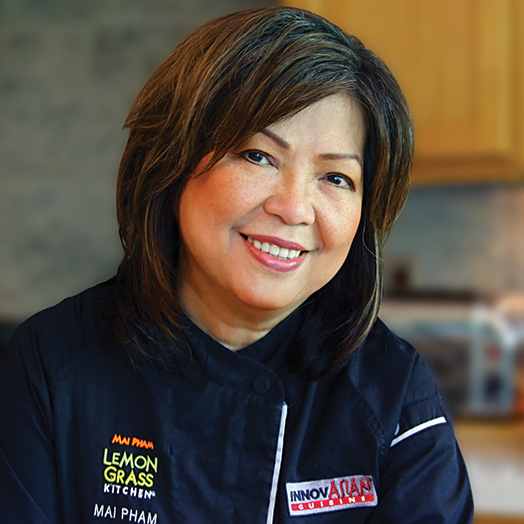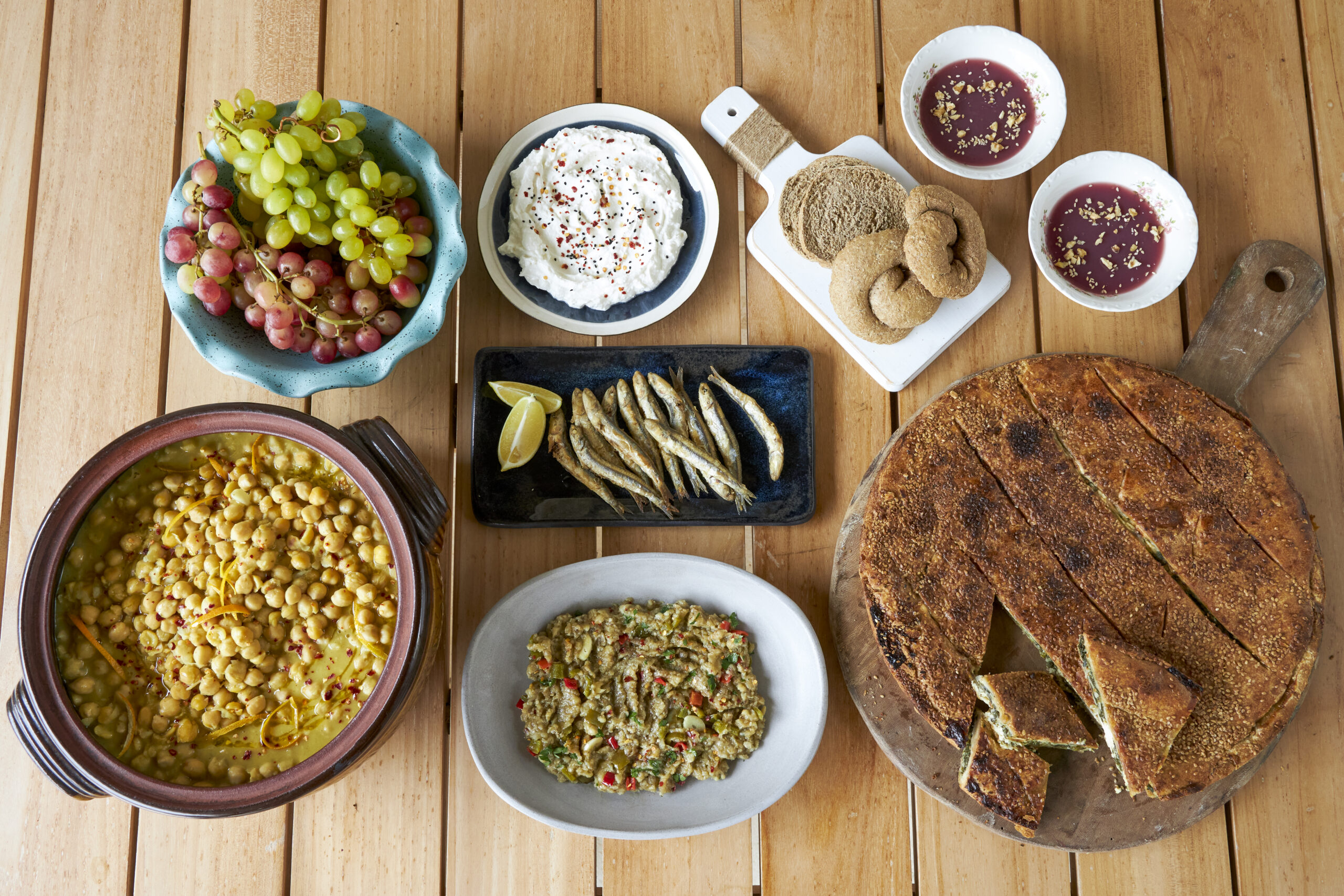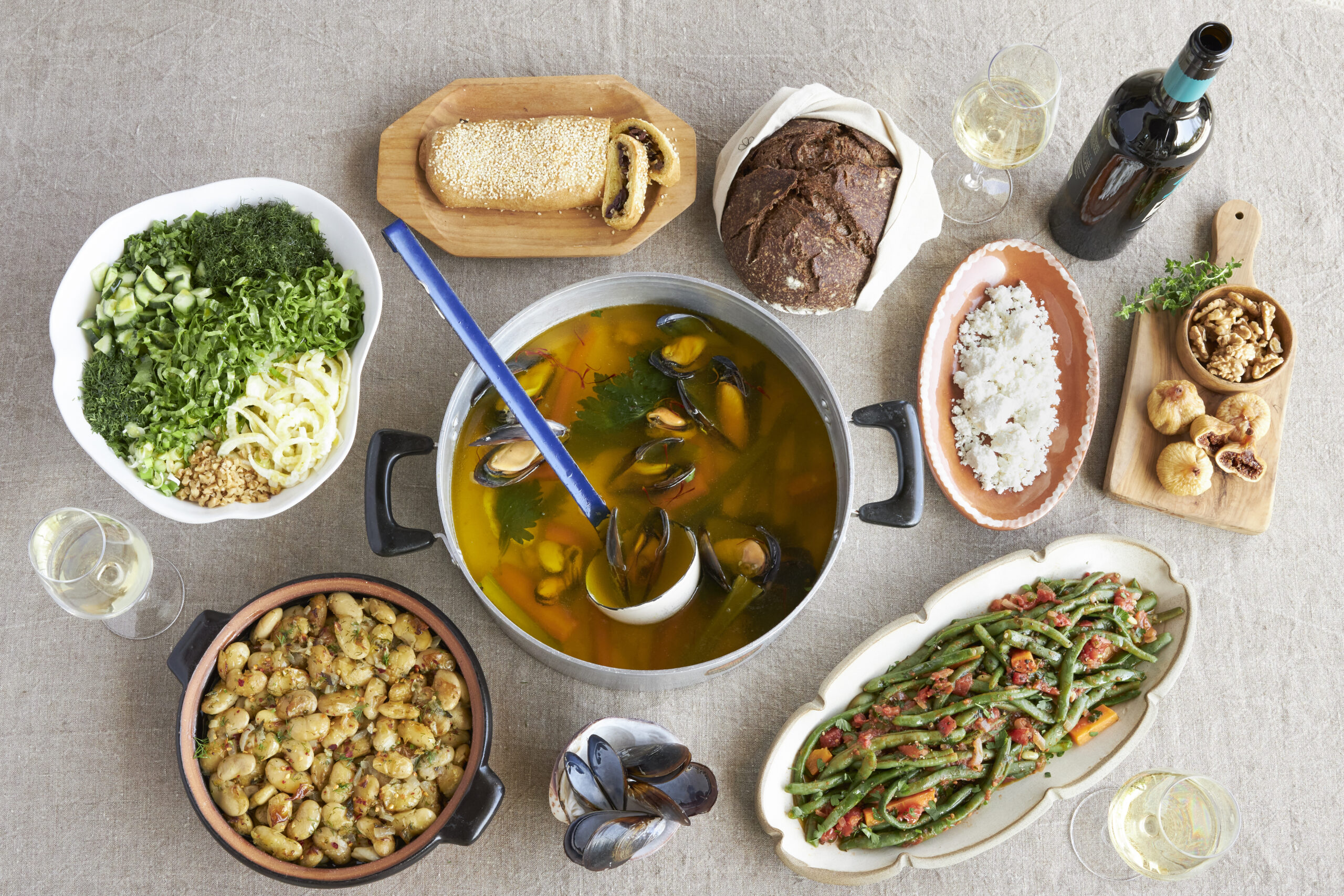Vietnam and the
Plant-Forward
Kitchen
The traditional Vietnamese cuisine serves as a cultural model for healthy, sustainable eating, closely aligned with the Planetary Health Diet.
The plant-rich cooking of Vietnam emerged as a result of a unique combination of geographical, climatic, cultural and religious influences evolving over many centuries.
Situated in the tropics, Vietnam has a monsoon climate with high annual rainfall and hot temperatures. Much of the country is mountainous, which together with run-off from the distant Tibetan plateau created a land of rivers. While the Red River in the north and the Mekong in the south (both with enormous, fertile deltas) are well-known vital waterways, a drive from north to south makes evident that Vietnam has one of the highest river network densities of any country in the world.
All of this makes for a rich and productive agricultural environment. Rice production yields two crops per year in the North and, commonly, three in the South. Small-holder farms throughout the country produce an enormous bounty of vegetables, herbs and tropical fruits. The rivers, along with a 2,000-mile coastline, and a robust aquaculture sector make for a substantial annual catch of fish and shellfish. Seafood is ever-present in the Vietnamese diet, though portions are typically small.
Traditionally, vegetables, rice, fish, tofu and fruit constituted the typical rural Vietnamese diet with meat (principally pork) playing a more minor role. Other plant protein sources besides tofu—including peanuts and cashews; black, red and mung beans; and soy milk—are ubiquitous in the diet. This aligns with the Planetary Health Diet (PHD) imperative to move contemporary global dietary patterns towards greater reliance on plant protein.
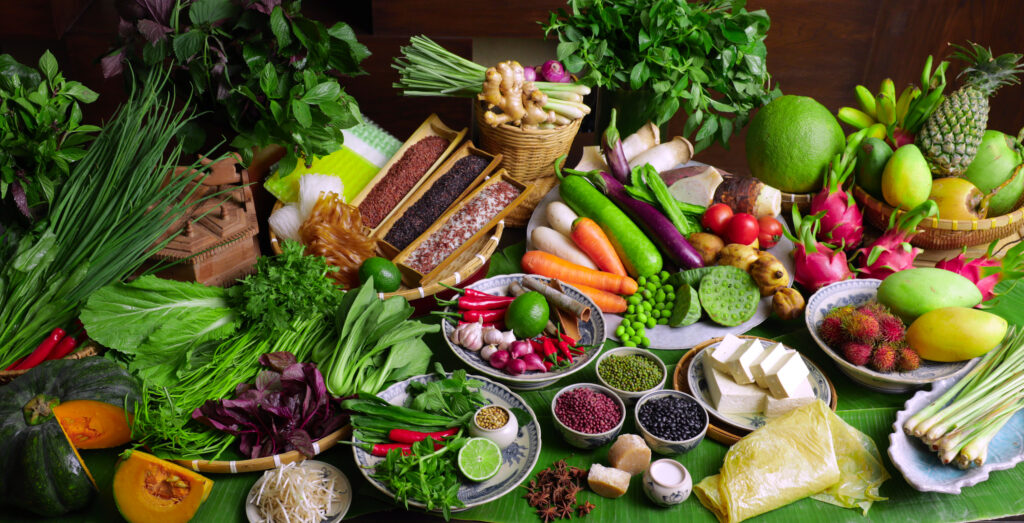
Situated on a peninsula between China and India, Vietnam and its cuisine have long been shaped by those influential civilizations. China ruled Vietnam for roughly 1,000 years until 905 CE. Cooking methods such as steaming, frying and stir frying, and frequent use of soy milk, tofu, noodles and eating with chopsticks are just a few examples of Chinese influence. Curries, coconut milk and spices are legacies left from thousands of years of trade between the Mediterranean, Africa and South and Southeast Asia.
Buddhism, brought to the country by both Indians and later by Chinese, calls for a vegetarian or vegan diet. Today, only a small minority of people in Vietnam identify as being Buddhist, but the religion remains a strong influence on the culture and cuisine. The French colonial period, which lasted only 100 years until the mid-1950s, left important marks including the iconic banh mi bread and ca phe or coffee.
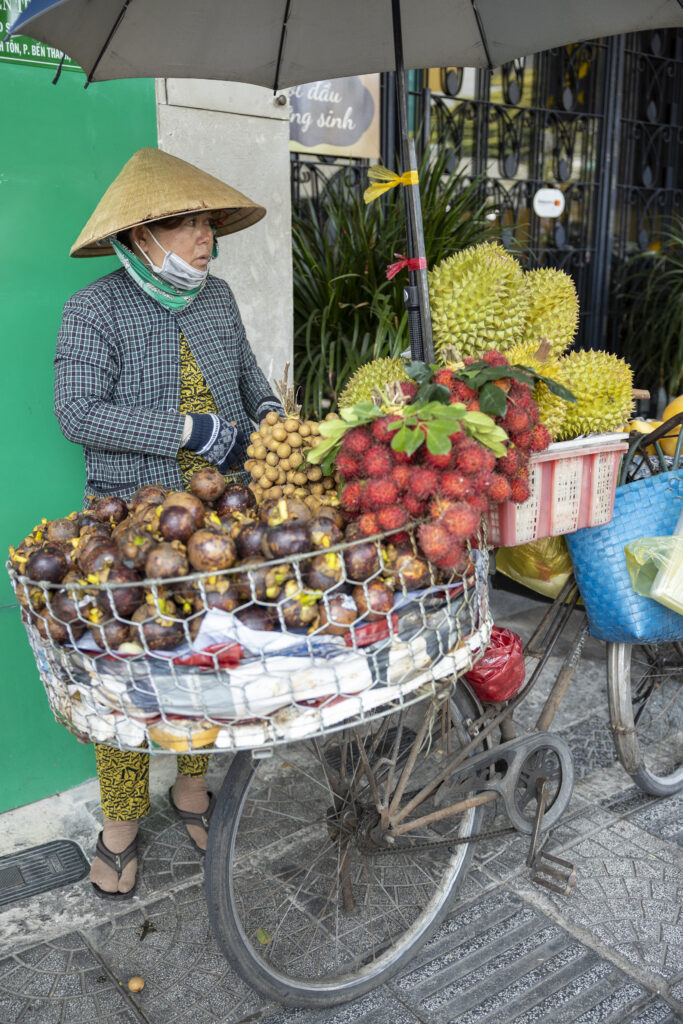
Traditionally, fruits and vegetables were at the very core of the Vietnamese kitchen. Vegetables would typically make an appearance in several dishes at the family table—including, for instance, a brothy soup, stir-fried greens with garlic, a pomelo salad, and a platter piled high with mustard greens and four or five herbs for wrapping pieces of Vietnamese crepes, spring rolls, or other savory bites.
Fermentation plays a key role in making plant-rich Vietnamese cooking savory and craveable. Fermented fish sauce is essential in the cuisine for enhancing flavors both during cooking and at the table. When blended with lime, chilies, garlic and a little sugar, nouc cham—a thin dipping sauce resembling a very light dressing—flavors and balances the entire meal. It would not be an exaggeration to say that nuoc mam, the undiluted fish sauce, and nuoc cham, the diluted and blended dipping sauce, are what define Vietnamese cuisine.
In contemporary Vietnamese food culture, as is the case in many countries around the world, sodium consumption can be a concern. In Vietnam, a principal source of sodium is dipping sauces that are always served on the side making it easy for diners to customize (and reduce) their usage. It is also important to note that many vegetables—boiled or raw as in “table salads”—always come to the table without any added sodium. Finally, rice in Vietnam is typically served completely unsalted.
While plant-rich cooking is at the heart of Vietnamese home cooking, fruits and vegetables also play an integral part of urban Vietnamese street food. “Even truck-stops along the nation’s highways boast abundant vegetable options,” commented chef Mai Pham. “One wouldn’t be surprised to find, in such a place, a choice of five or six different Asian greens prepared several different ways.”
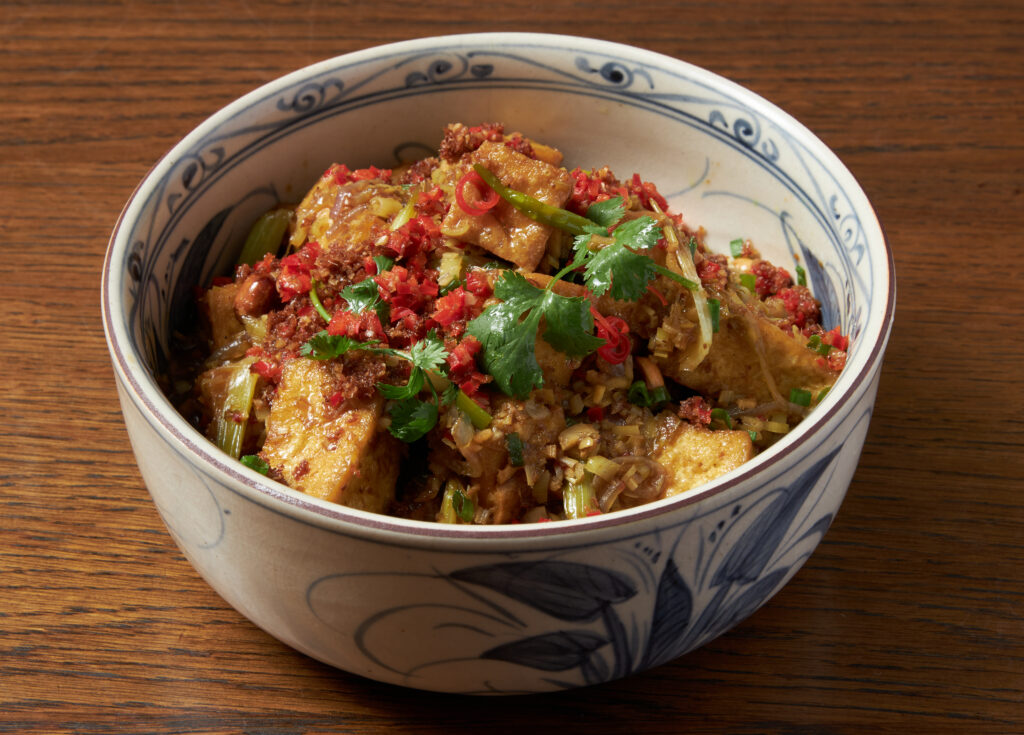
Today, as with many traditional cuisines around the world, increased consumption of meat, processed foods and sugary drinks together with a surge in urban, sedentary lifestyles has led to rising rates of obesity, diabetes and other chronic diseases. But the traditional, plant-rich dietary pattern and the availability and abundance of plant-sourced foods are still a defining characteristic of Vietnamese food culture. All this inspires us all to discover, or rediscover, the appeal of the healthy, sustainable plant-rich kitchen.
The cooking and photography for this Vietnamese edition of Our Cultures, Our Meals: Cooking for Planetary Health took place in and around Ho Chi Minh City. All of the menus for the featured meals are designed for a gathering of six (6) friends and family members. A few photographs of Vietnamese street food round out the story of the traditional food culture and dietary pattern.
Vietnamese Family Meal 1
Mung bean noodles, mien xao cai, are quickly stir-fried with peppers, carrots and garlic. Squash blossoms, bong bi xao, are passed through a wok and topped with fried shallots. Unripe green mango provides refreshing tang in this salad, goi xoai, which is tossed with seared tofu and peanuts. Black sesame rice crackers are used to scoop up the salad. A claypot holds vegetable curry, ca ri chay, made with coconut milk, chunky sweet potatoes, squash, carrots and mushrooms. Tofu and mushroom spring rolls, goi cuon, are wrapped with thin, translucent rice paper. Brown rice wrappers could be substituted for a whole grain boost as is recommended in the Planetary Health Diet (PHD). A fermented bean sauce, similar to hoisin, is used to make the dipping sauce. (One could say Vietnamese cuisine is about dipping sauces.) Aromatic fresh herbs accompany the salad rolls but are also enjoyed as a “table salad” providing both fresh, crunchy and contrasting textures to the overall meal. Whole grain red rice and a platter of pineapple, passion fruit, mango and dragon fruit round out the meal.
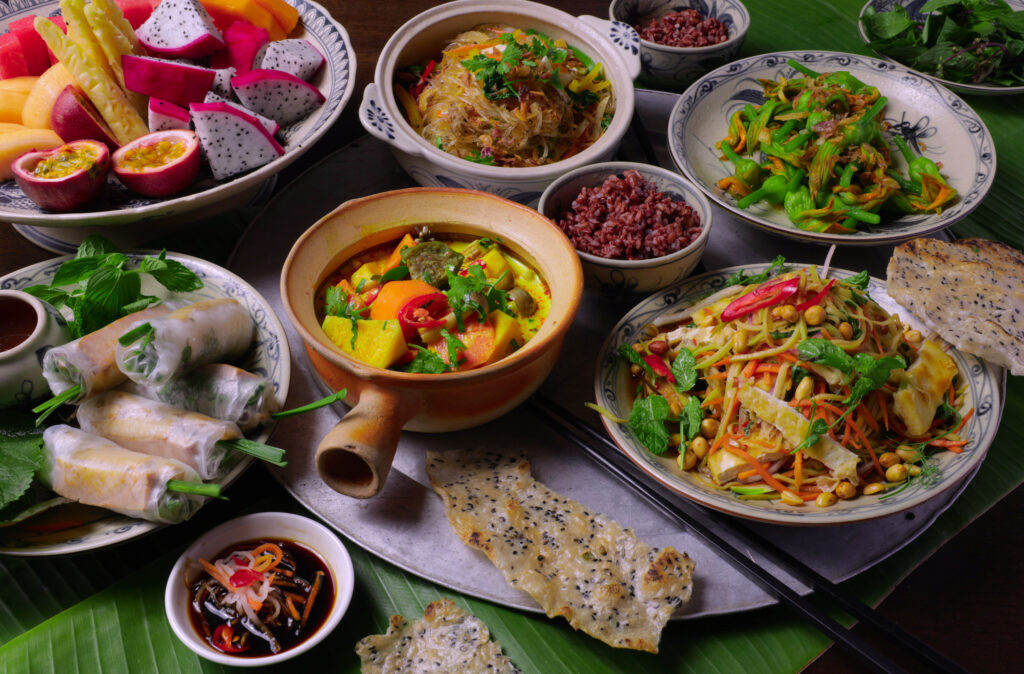
Vietnamese Family Meal 2
Wing beans, a delightful crunchy vegetable somewhat similar to starfruit, team up with stir-fried tofu and red chiles in this room temperature salad, goi dau rong voi dau hu. Crispy vegetarian spring rolls, cha gio chay, are served with lettuce, herbs and the quintessential nuoc cham, a dipping sauce of lime and/or vinegar, fish sauce, chiles, garlic and balanced with a tiny bit of sugar. Rice, in this case, red (whole grain) rice, is a standard part of meals. For claypot fish, ca kho to, catfish is braised in a sand pot with caramel sauce. This hot & sour soup, canh chua chay, features taro stems, tomato, pineapple, fresh saw leaf and rice paddy herbs. Peanuts, basil and red chilies top lemongrass tofu, dau hu xa ot. Meals typically end with freshly cut fruit but sometimes with a more indulgent coconut, red bean and banana pudding, che chuoi chung.
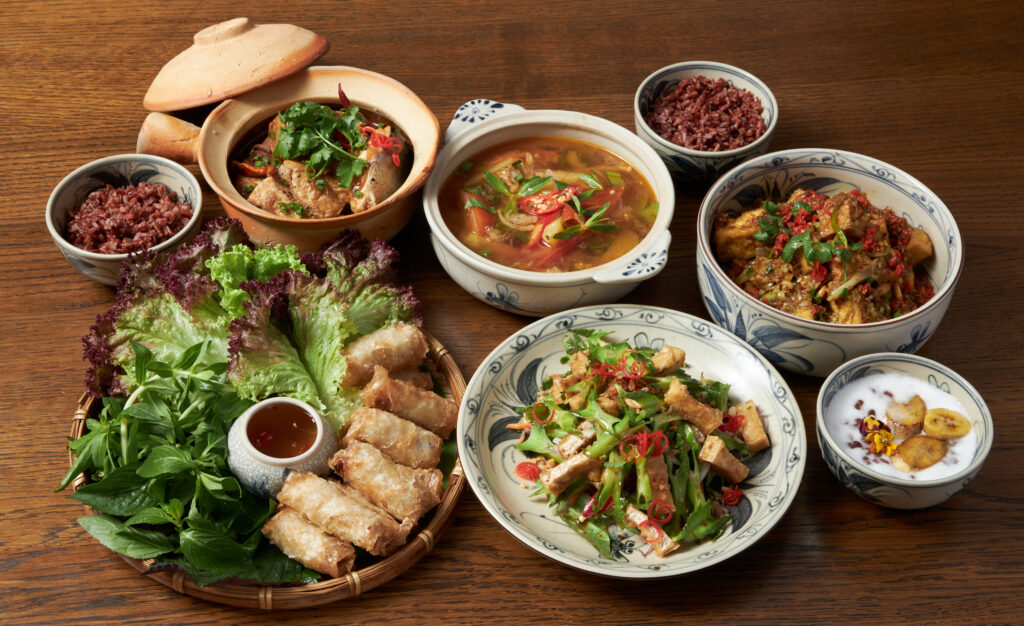
Vietnamese Family Meal 3
This meal includes chicken and seafood in small portions. For ca hap gung hanh la, black cod is steamed and served with a soy, scallion, ginger and chile sauce. Claypot chicken, ga kho gung, is braised with ginger and fish sauce. A few tablespoons of minced shrimp add umami to the opo squash soup, canh bau. This meal pattern reflects both the recommendations of the Planetary Health Diet (PHD) to include servings of fish a couple of times per week and the flexibility of the PHD to, more broadly, allow variation in amounts of animal protein from day to day giving priority to weekly targets. The bulk of this meal is fruit and vegetables: stir-fried morning glory with garlic, rau muong xao toi; a salad of shredded pomelo, goi buoi, with tofu, fresh herbs, red onions, chilies, lettuce and chopped peanuts. Sliced watermelon is often an accompaniment to claypot dishes, and red or brown (whole grain) rice provides the foundation for the meal.
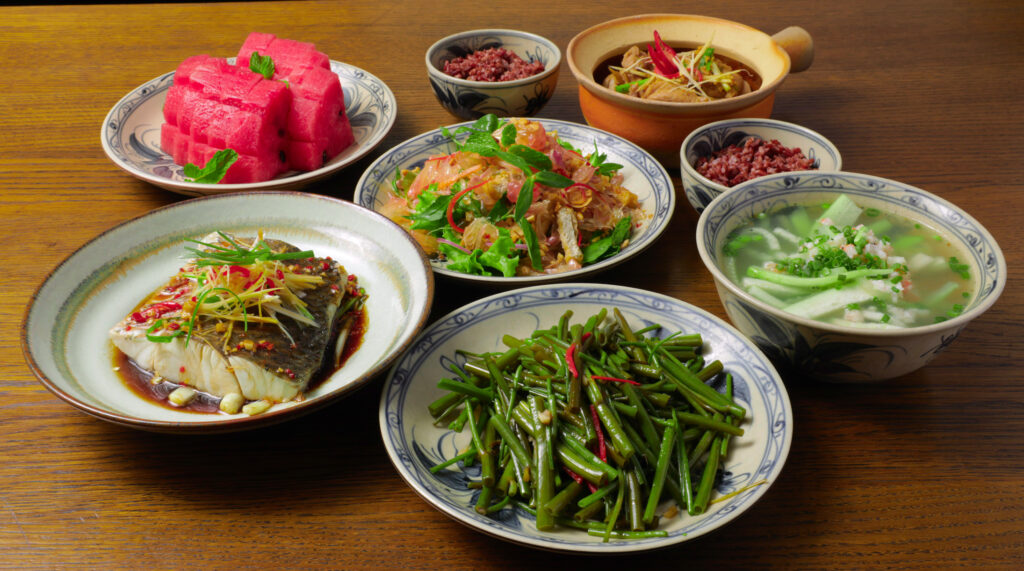
Vietnamese Family Meal 4
The chefs at Saigon’s Vinh Nghiem Pagoda restaurant take pride in colorful, decorative presentations showcasing the bounty of the plant world. Completely vegan, the restaurant specializes in mushrooms—they appear in 6 dishes in this spread. (Clockwise, from top left.) Cai thap cam luc lac, shaking vegetables, is the vegetarian version of the famed shaking beef dish or bo luc lac and made by ‘shaking’ ingredients in a fiery hot wok and served on fresh pineapple and baby watercress. This claypot tofu, dau hu kho to, is braised in dark soy sauce along with mushrooms. Soy-lime dressing seasons this goi chay dau hu, a salad of sliced mushrooms, julienned vegetables and fresh herbs, served with rice crackers. Both lemongrass tofu, dau hu xa ot, and pan seared chanterelle mushrooms, nam chien chanterelle, are accompanied by fresh herbs including green perilla and mint, adding refreshing flavors to each bite. Vegetable-fried red rice with lotus seeds, com chien chay hat sen, is a version often served at temple vegetarian meals. Morning glory, rau muong xao toi, is stir-fried with garlic and topped with crispy shallots. Enoki mushrooms cooked with caramel sauce, soy & ginger, nam kim cham kho chay, are savory and smoky. Instead of rice paper, mustard leaves are used to wrap cuon diep, filled with mushroom and tofu and served with peanut sauce. A simple stir-fry of choy sum, cai ngot xao, becomes quite craveable with umami-rich mushrooms. Pomelo, watermelon and guava provide a satisfying finish to the meal. This meal highlights the central importance of sufficient amounts of vegetables and fruits in our diets as recommended by the EAT-Lancet Commission (Planetary Health Diet (PHD)). At the same time, it also demonstrates how the repertoire of culturally rooted, heritage vegetarian cooking in Vietnam can be a rich source of inspiration to make these dietary patterns easily, and deliciously, achievable.
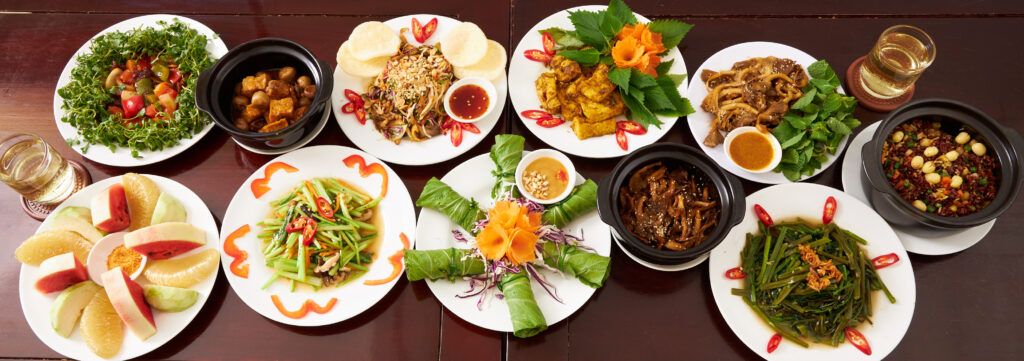
Vietnamese Family Meal 5
Tuan and Tu restaurant in Saigon fills crispy spring rolls, cha gio, with crab and root vegetables and serves them with rice noodles, lettuce, herbs and a nuoc cham dipping sauce. This braised tofu, stuffed with a mushroom-pork blend, dau hu nhoi thit, shows off the Vietnamese creativity with tofu as well as the idea of combining mushrooms with animal proteins in a recipe as a way of limiting one’s meat consumption (and, at the same time, creating greater savoriness). Baby gai lan stir-fried with garlic, cai lan xao toi, and grilled eggplant topped with scallions, peanuts and a tamarind–vegetarian fish sauce dressing, ca tim nuong, illustrate how simply prepared vegetables can be so satisfyingly savory. Banana blossom salad, goi bap chuoi, with its medley of ingredients, arrives ready to be tossed at the table. Black (whole grain) rice accompanies the spread. Black sesame dumplings in ginger broth, or che me den troi nuoc gung, provide a warm finale to the meal. This meal, as well as all of the others photographed in this edition, reveals how traditional Vietnamese meals—with their typical diversity of dishes and flavors—can easily deliver the wide range of foods recommended in the Planetary Health Diet (PHD) and, by doing so, better connect with the imperative of preserving agrobiodiversity highlighted by the 2025 Eat-Lancet Commission. The lack of a main, large entrée of animal protein in Vietnamese food culture unlocks more culinary pathways to securing a healthy, sustainable, delicious plant-rich dietary pattern that is not necessarily vegan or vegetarian.
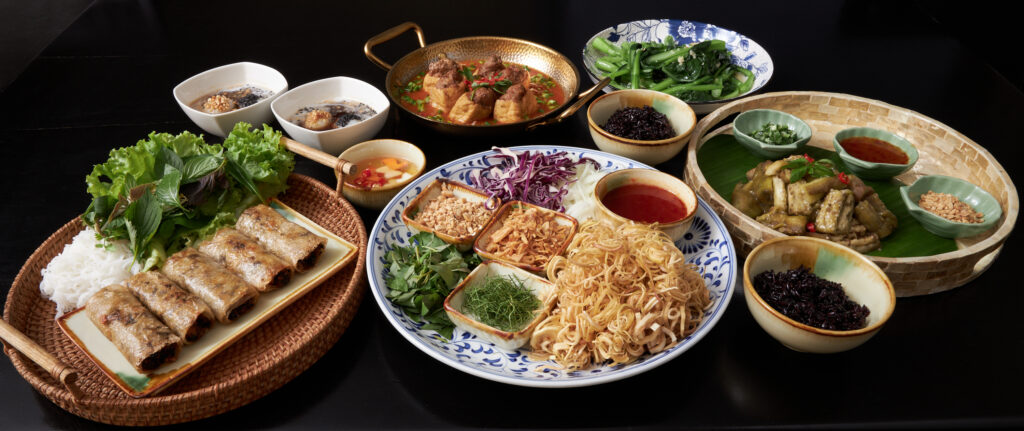
Vietnamese Family Meal 6
Abundant fresh herbs such as Asian basil, perilla, mint, saw leaf, rice paddy herb and amaranth are a signature of Vietnamese cuisine. They are often referred to as ‘table salad’ and are served layered on a large platter. A bowl of rice is a standard accompaniment, but rice also appears in the form of noodles and wrappers and may be brown, red or black (all whole grain) as well as white. Vegetables easily take up more than half of many meals. You’ll find Shanghai choy, Chinese mustard greens, chrysanthemum, kabocha squash, mung bean sprouts, mushrooms, radishes, tomatoes, wing beans, eggplant, carrot, taro and fuzzy melon to name just a few. From banana and pineapple to pomelo, mango, dragon fruit, toddy palm and rambutan, fruit is ubiquitous and finds its way into salads dressed with a sweet, sour and spicy dressing. Lime often features in those dressings and is a source of acid for numerous other dishes. Mung beans, lotus seeds, and black and red beans are eaten as well as such soy foods as tofu, tofu skin and soy milk—all important sources of plant protein. Peanuts, the traditional nut of Vietnam, and cashews represent another significant source of healthy plant protein in the diet. Common seasonings include ginger, lemongrass, shallots, garlic, chili peppers, star anise and cinnamon. Palm sugar and coconut cream are used in both savory and sweet dishes. With such an enormous array of plant-sourced ingredients used in the Vietnamese kitchen, it’s easy to see how the Planetary Health Diet (PHD) can be both creative and delicious. The pairing of small, optional amounts of animal protein in supporting roles with larger amounts of plant foods is a culinary strategy that has been practiced and refined over millennia in Vietnam.

Saigon Vegetable Curry
Archaeological evidence suggests that the spice trade from India had reached southern Vietnam over 2000 years ago and people were grinding spices and roots— turmeric, ginger, nutmeg, clove, cinnamon and galangal among others—to make curries. The use of galangal, is often used in Vietnamese curries, salads and braises. This vegetable curry, ca ri chay, is rich with coconut milk and topped with onions and herbs.
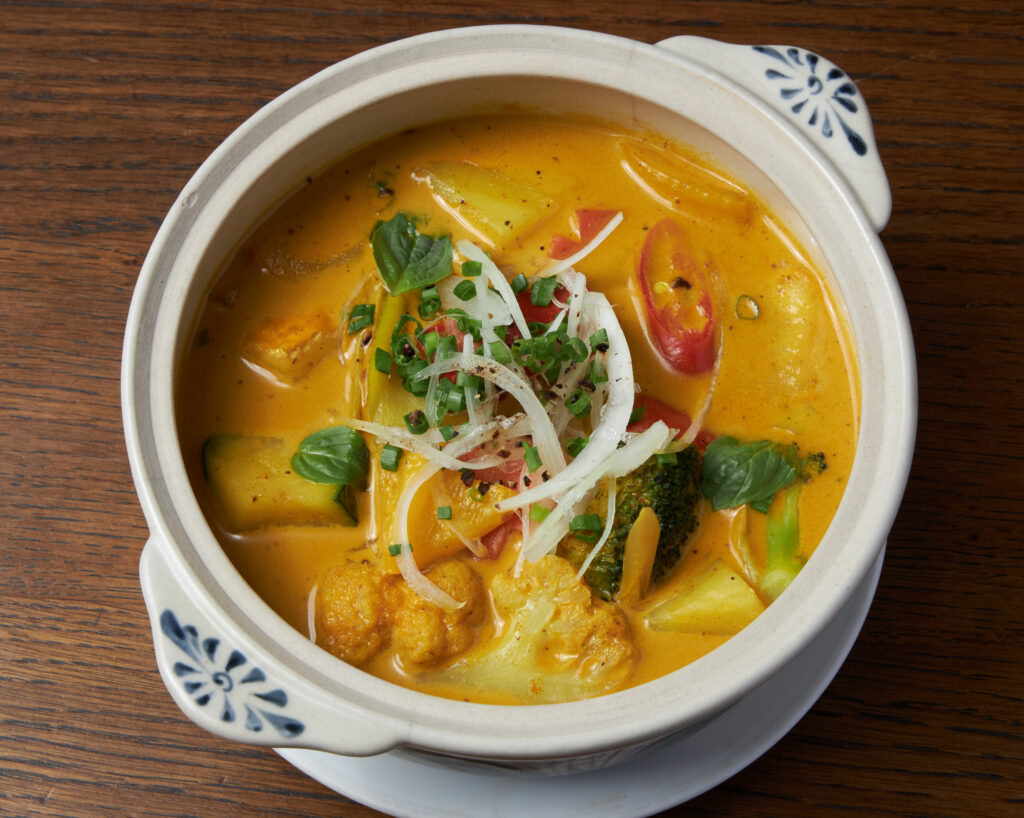
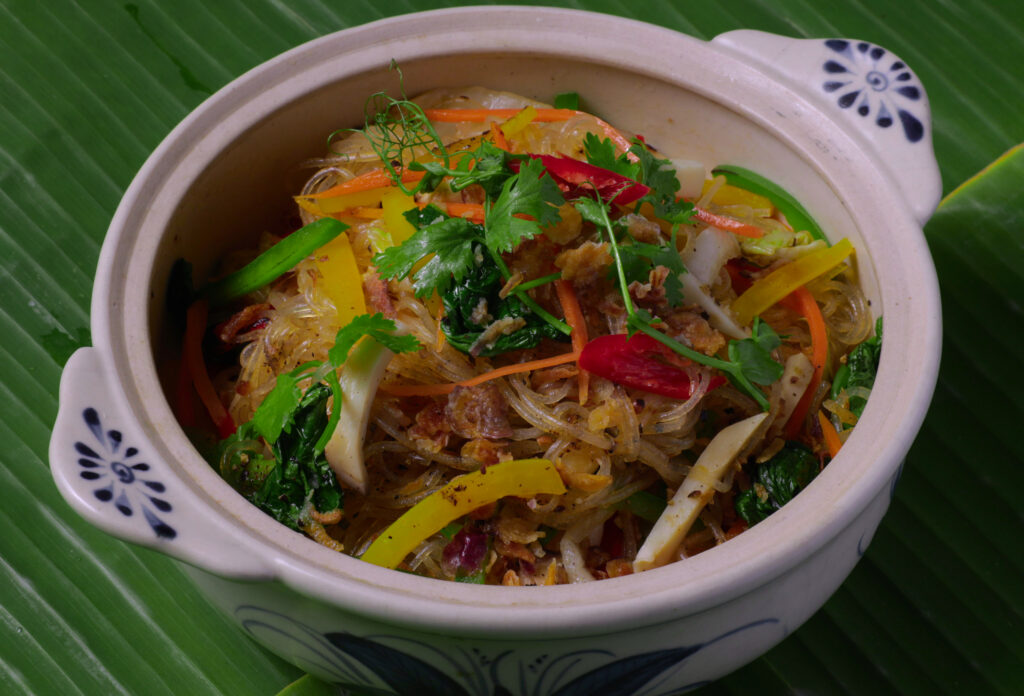
Stir-Fried Mung Bean Noodles with Vegetable
In Vietnam, noodles commonly appear in brothy soups such as pho but they’re also eaten in dry noodle dishes such as in bun served with grilled meat or fish. Additionally, they’re stir-fried as in this mung bean noodle with vegetables dish called mien xao cai. Also known as glass noodles or cellophane noodles, mung bean noodles are made with mung bean starch.
Crispy Vegetarian Spring Rolls with Table Salad
Crispy spring rolls, cha gio are made withrice paper filled with tofu, mushrooms, carrots and onions. To enjoy, one would wrap them with lettuce and any combination of herbs such as mint and rau ram and then dipped in nuoc cham, a dipping sauce of fish sauce, lime, garlic and chiles. These rolls, as well as other stir fried and fried foods, are cooked in vegetable oil because of its neutral flavor. Made from soybeans, corn, canola, peanuts or rice bran—or a combination of these—vegetable oils used in Vietnamese cooking are plant-based and typically composed of unsaturated fats.
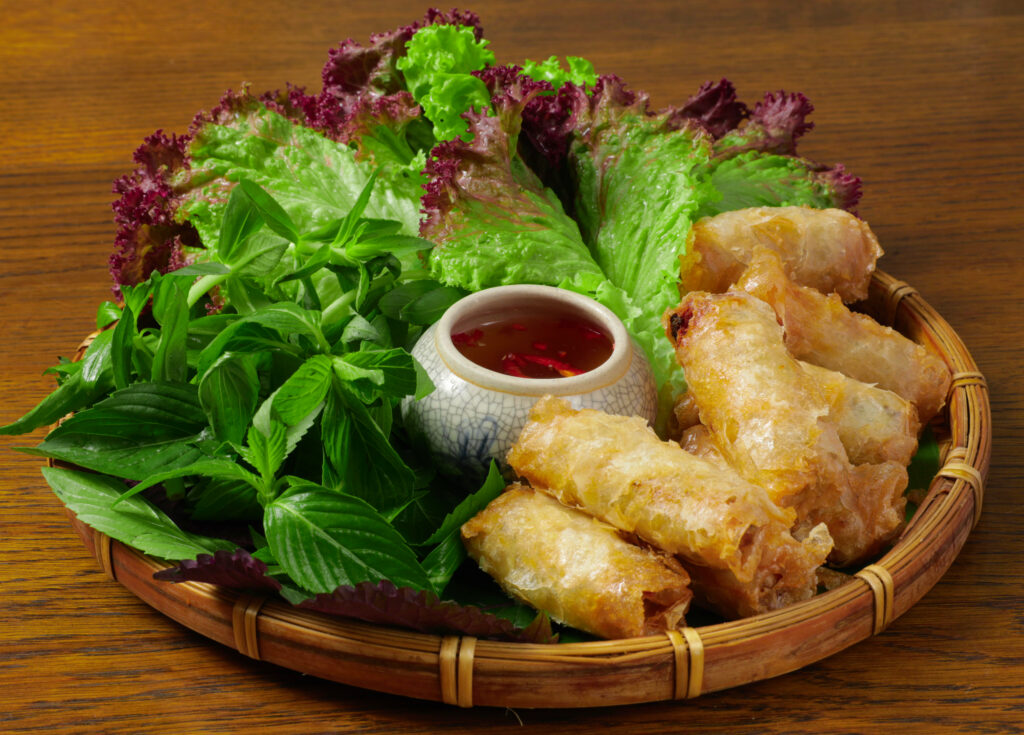

Lemongrass Tofu
Tofu, which is made from soybeans, is one of the primary ways that legumes appear in the Vietnamese diet. In this lemongrass tofu, dau hu xa ot, the tofu is marinated in fresh chopped lemongrass, chilies, soy sauce, salt and a bit of sugar before it is quickly fried with garlic, shallots, onion, peanuts and fresh herbs. Tofu is “very important to both vegetarian and non-vegetarian diners because it’s an affordable protein and very versatile,” says chef Pham. “When I was growing up, many of our family meals were made with different kinds of tofu, prepared in different styles alongside interesting vegetables such as pumpkin, opo squash, chayote and flowers such as Tonkin jasmine flower. The final result was more substantive, as opposed to serving a side of vegetables.”
Opo Squash Soup
Opo squash soup, canh bau, falls into the category of brothy soups that are easy to make and served as part of most Vietnamese meals. Opo squash is a gourd, but when harvested young, is tender and can be cooked like zucchini. In this mildly flavored soup, the squash is simmered in broth and seasoned with minced shrimp and scallion.
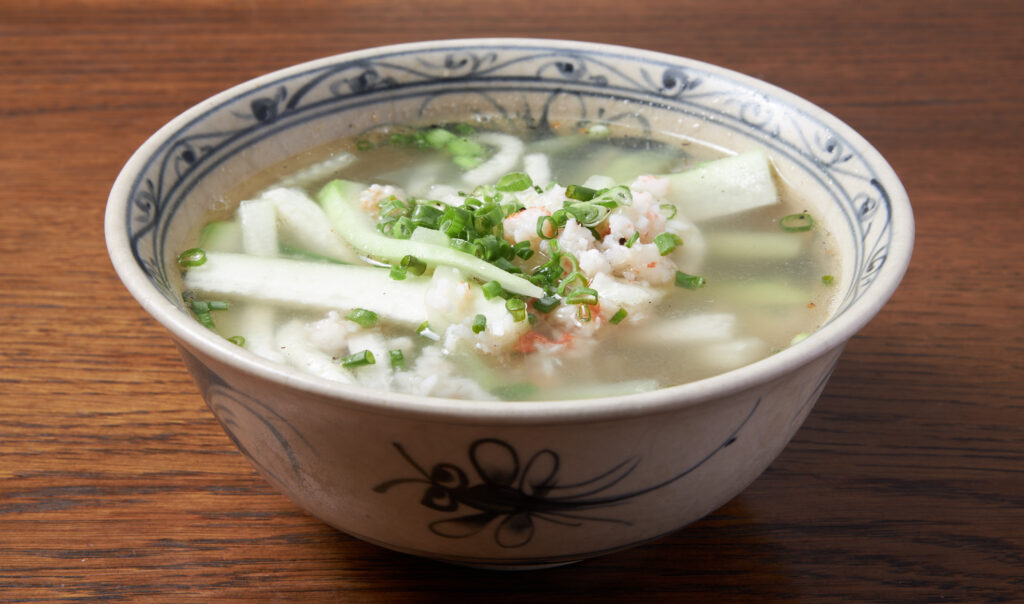
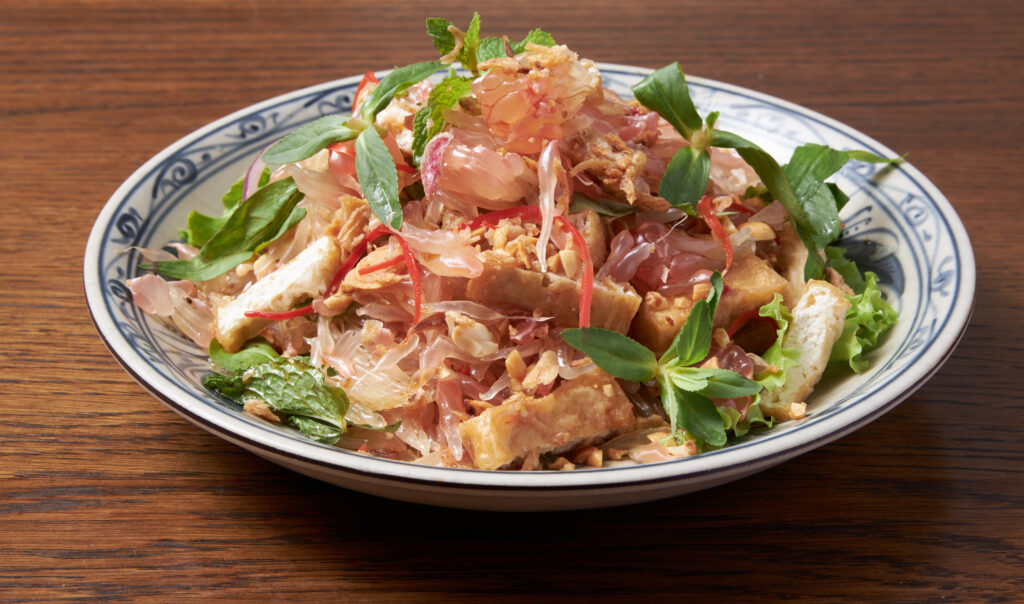
Pomelo Salad
Salads are commonly served as part of a Vietnamese meal. Often made with fruit, including unripe green mango or papaya, the salads are typically tossed in a spicy, tangy dressing made with fish sauce, garlic and chilies. This shredded pomelo salad, goi buoi, is made with tofu, mint, rice paddy herb and peanuts. Sweet and sour pomelos are native to Asia and are the largest type of citrus.
Temple Fried Red Rice with Lotus Seeds
The Mekong Delta is the most important rice producing region in Vietnam. The rice crop grows in flooded paddies. Once harvested, production facilities thresh, hull, sort and polish the rice. During this process, if the bran is stripped, brown rice becomes white. While today white rice is still prevalent, historically most rice was not processed to this degree and unrefined brown rice was more common. The Vietnamese are slowly gravitating back to brown rice, says chef Pham. “In the last 10 years, people are more aware that brown rice is a healthier option,” Other whole grain rice options, including red and black rice, are also grown in Vietnam. “Black or red sticky rice, often served with mung bean paste and freshly grated coconut is a popular breakfast food. They’re also enjoyed as snacks and desserts,” according to chef Pham. This vegetarian temple fried rice, com chien chay voi hat sen, features red rice tossed with lotus seeds. In Vietnam, legumes and nuts—especially peanuts—are eaten as snacks and used in salads, braises and desserts.
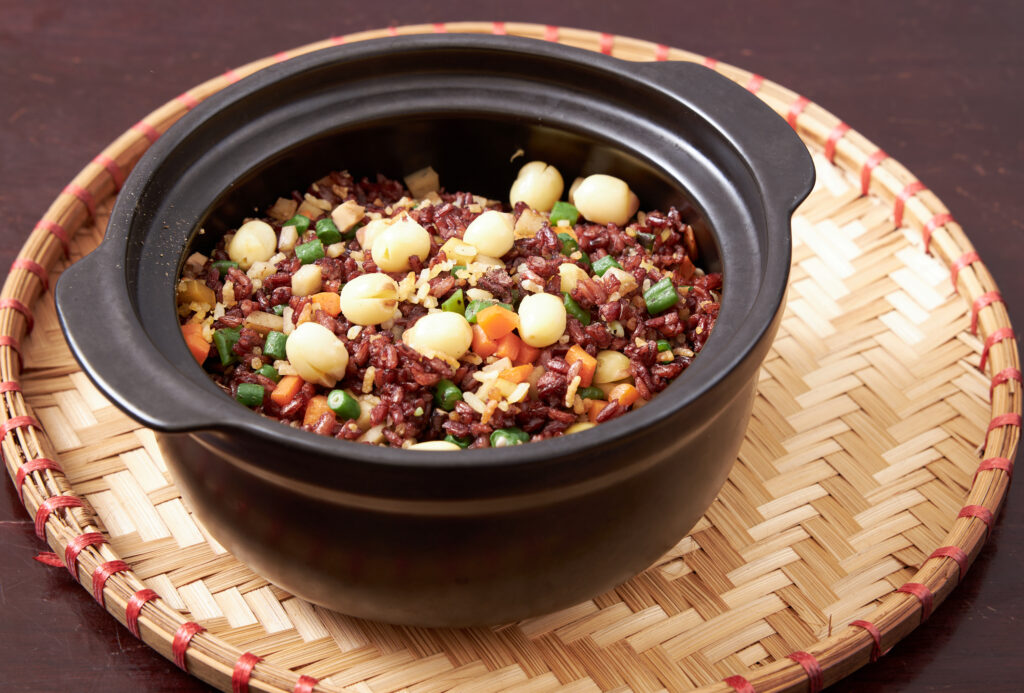
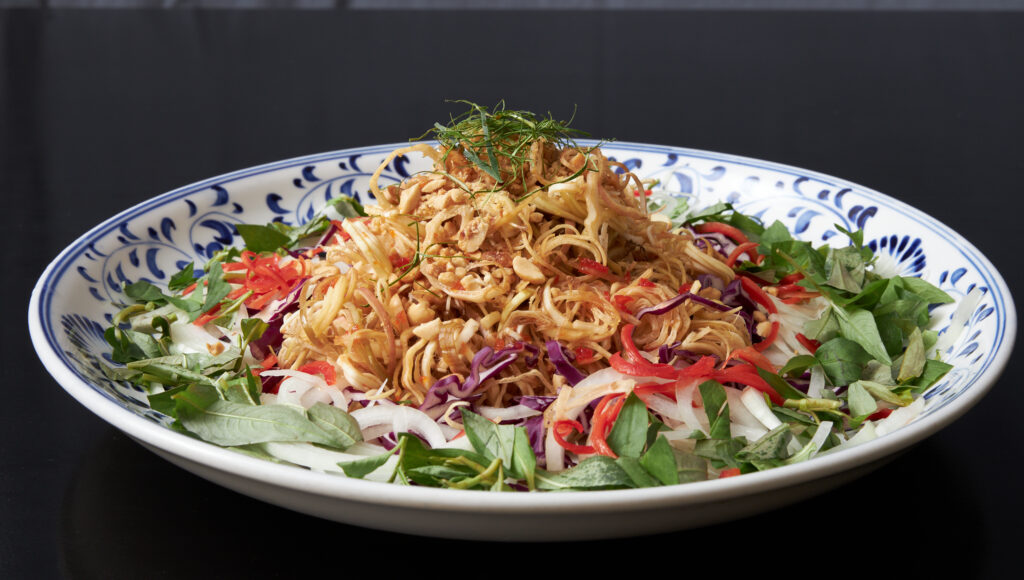
Banana Blossom Salad
“In Vietnam, bananas grow wild and practically everywhere,” according to chef Pham. “Instead of waiting for them to bear fruit, we harvest the blossom when they’re still green. You shred them up and they become food.” For this salad, goi bap chuoi, the baby bananas are removed and just the inner part of the blossom is shredded and soaked in water. The blossom tastes a little tannic and according to Pham, “if it’s freshly harvested, it’s very fragrant.” Red cabbage, red chilis, onion, makrut lime leaves, rau ram, fried shallots, peanuts and a tamarind dressing are tossed with the shredded blossom. Used as a topping here and in many other salads, peanuts are one of the key sources of legume consumption in the Vietnamese diet.
Ben Thanh Market: Fresh Greens and Herbs
At Saigon’s Ben Thanh Market, vendors offer endless rows of vegetables. But it’s perhaps the greens and fresh herbs that are the most glorious. And it makes sense since greens and herbs are so integral to Vietnamese cuisine, a characteristic unlike what one finds in other Asian cuisines. Chef Pham says that growing up, her mother would never go to the market without visiting a stall like the one pictured here. “There’s always a substantial pile of fresh herbs and lettuce at the family table. Always.” Here a vendor arranges water spinach, two types of watercress, chrysanthemum, amaranth and mustards among others. The denser vegetables like potatoes and cauliflower are less favored and take up very little room at her stand.
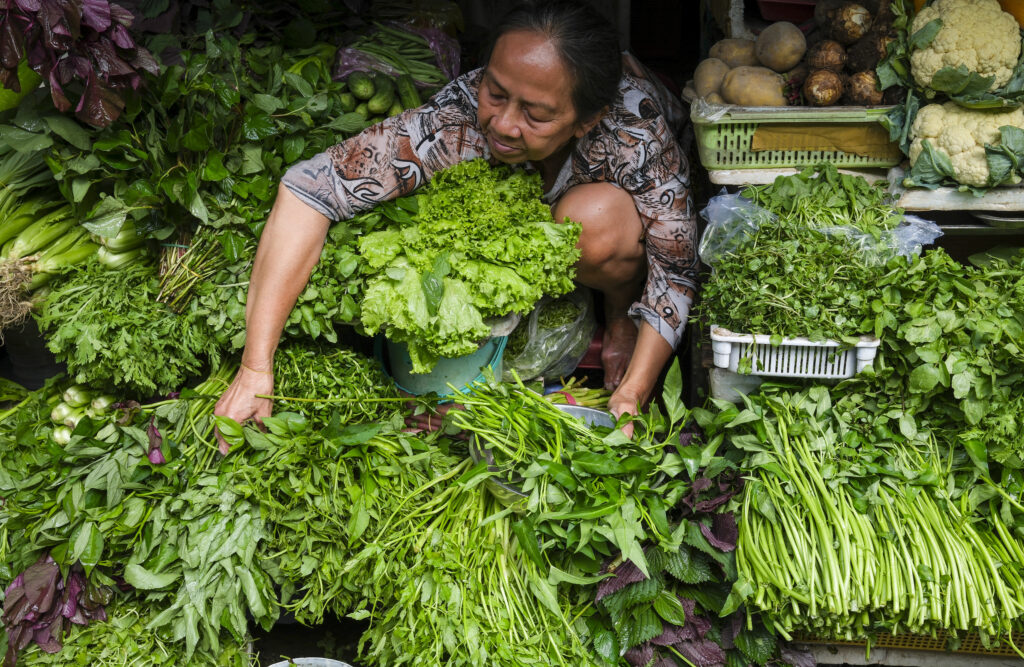
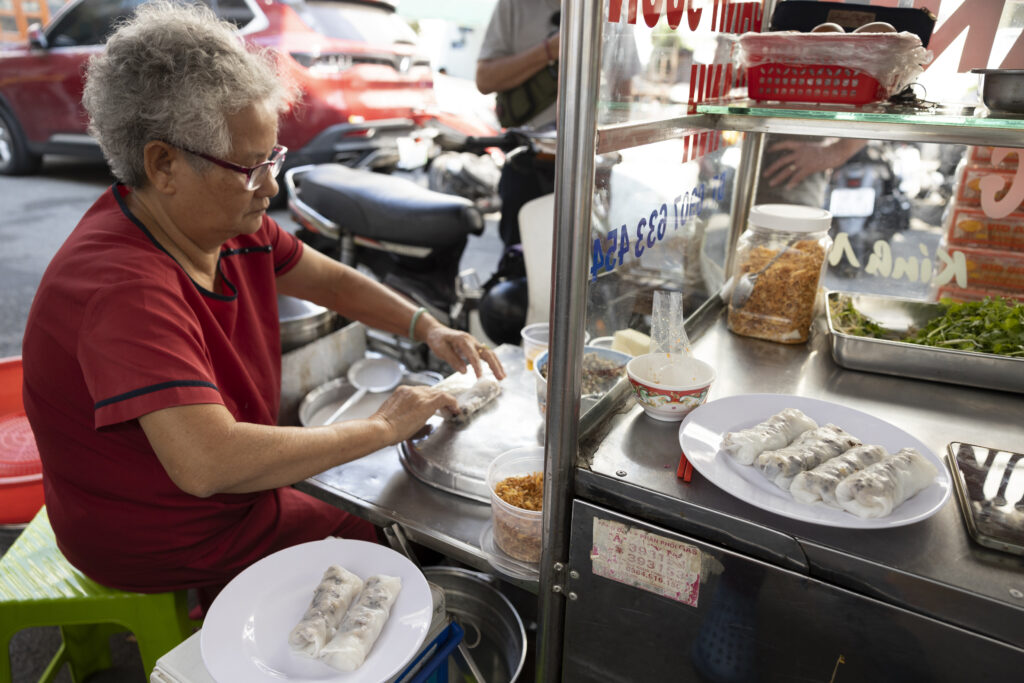
Street Food: Banh Cuon Thanh
After steaming the rice flour crepes, banh cuon, this vendor fills them with minced wood ear mushrooms and ground pork (stretching a small amount of animal protein with the umami-power of mushrooms). She serves them with a nuoc cham dipping sauce and tops them with fried shallot, bean sprouts and cilantro. She makes about 100 orders of rolls a day and has been doing it for 35 years. “There are thousands of these street food vendors who specialize in one dish and many of them have done it all their life. And before that their mother did.” As chef Pham explains, “these vendors are truly master chefs because they’ve been focusing on making and perfecting just one dish for 30 years.”
Local Restaurant: Pho Bo
Steaming bowls of beef noodle soup, or pho bo, are served for breakfast at Pho Dau in Saigon. Bouncy rice noodles and piping-hot broth are the heart of the dish, topped with paper-thin sliced beef, green onions, cilantro and lime. Making pho bo typically requires an overnight simmer of broth made from beef bones, charred ginger and onions, star anise, cloves and cinnamon. Traditionally, in Vietnam, the portion size of both the noodles and the beef is relatively small.
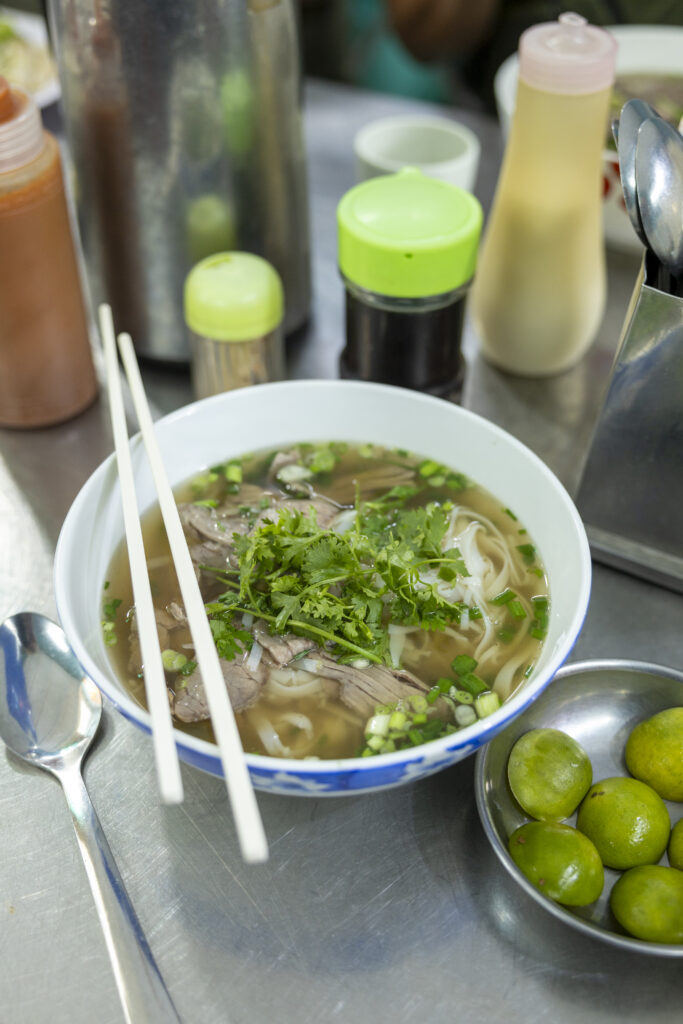

Fruit Vendor on Bicycle
With its tropical climate and fertile soils, Vietnam produces over 50 varieties of fruits. In Saigon, fruit is everywhere, and vendors often peddle their wares by bike, allowing them to slide through tight alleys, set up on street corners and find people near their homes. Usually, fruit is cheaper from these bike vendors than it is at the supermarket. Here a woman offers longan fruit and rambutan, both of which are part of the same family as lychee. Heaps of spiky green durian and mangosteen balance out her display.
Market Vendor: Cooking Razor Clams with Greens
At this seafood vendor in Ben Thanh market, a stir-fry of razor clams or oc mong tay xao rau muong, is fragrant of garlic and hot chilis. Vietnam is the fourth largest aquaculture producer in the world. Bivalves such as razor clams are a small but growing part of the industry. Farmed clams, mussels and other bivalves don’t require inputs and they filter and clean the water as they feed, so they are a particularly sustainable farmed seafood choice. This dish reflects the importance the 2025 EAT-Lancet Commission with its Planetary Health Diet (PHD) places on fish and other aquatic foods—with a special “call out” for bivalves including clams and mussels—in sustainably feeding an estimated planetary population of nearly 10 billion people by 2050.
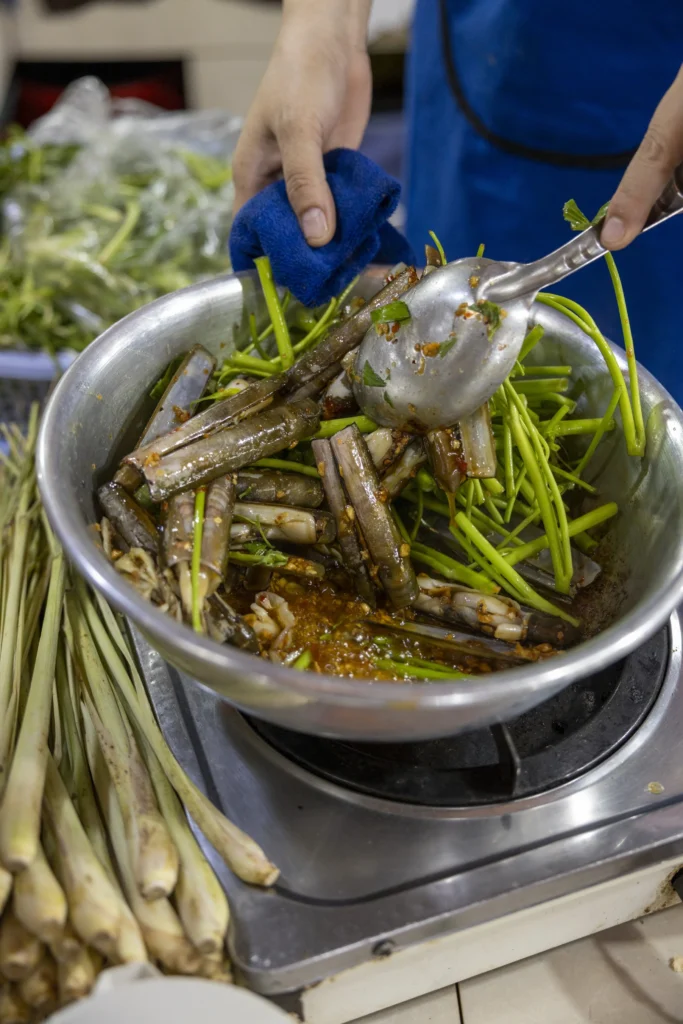
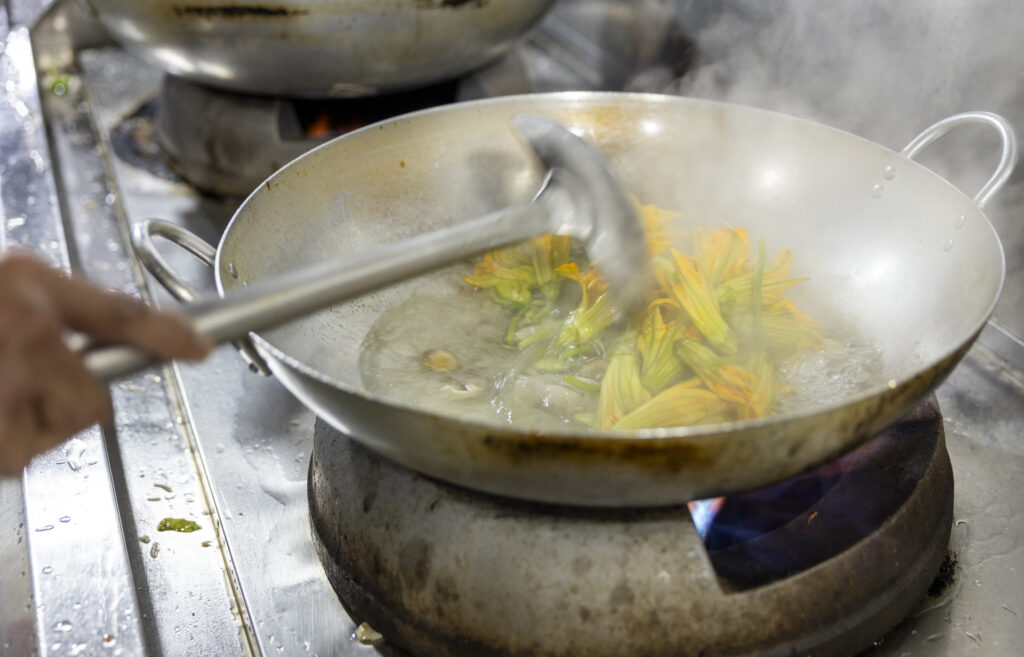
Cooking Squash Blossoms
Squash blossoms, bong bi xao, become an easy vegetable dish when they are briefly moistened and wilted in steaming water, then seasoned with sizzled garlic.
Iced Coffee with Calamansi and Spices
In Vietnam, coffee, which was introduced by the French in the 1800’s, is almost as beloved as tea. Today the country is the second largest coffee producer in the world, and its coffee culture is sophisticated and booming. In Saigon you’ll find cafes precisely measuring, brewing coffee and hand-crafting coffee drinks with fresh aromatics to order. This one is a memorable concoction of freshly squeezed calamansi (citrus), cold brew of robusta coffee with a light syrup steeped in a bouquet of star anise and ginger.
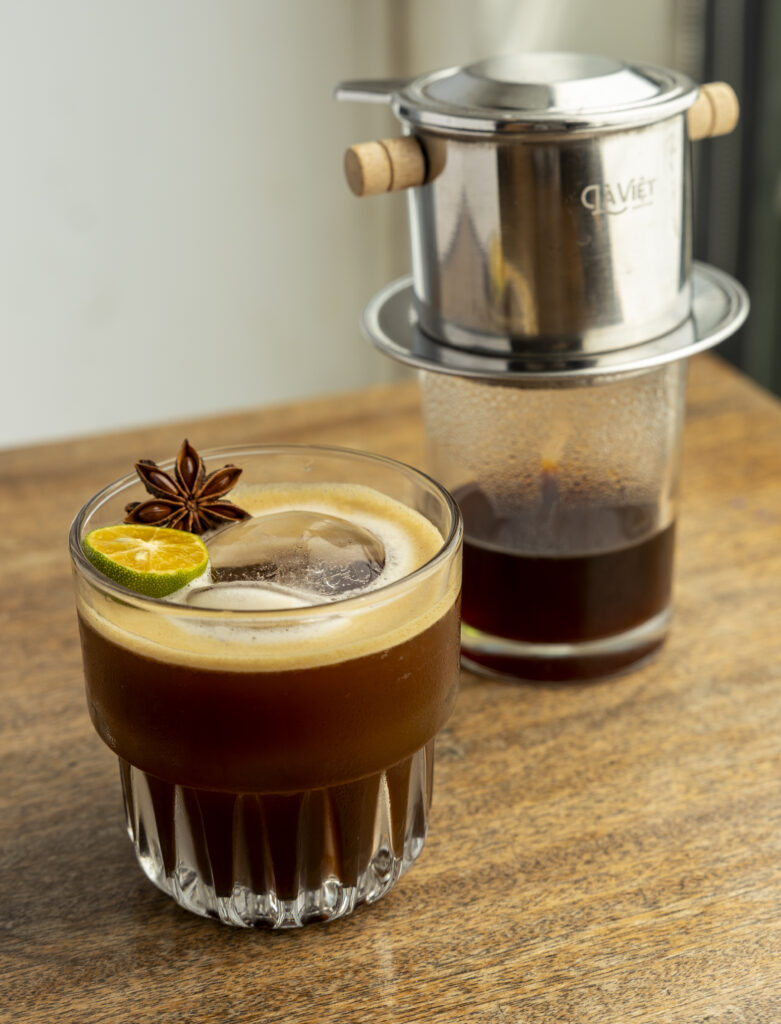
Project producer and editorial director: Jessie Price, consulting editor and former editor-in-chief, Eating Well magazine
Culinary director: Mai Pham, Vietnamese food expert; chef/owner of Lemon Grass and Star Ginger; author of Pleasures of the Vietnamese Kitchen, The Best of Vietnamese & Thai Cooking and Flavors of Asia
Photography: Penny De Los Santos, visual storyteller who has documented food and culture globally for 20 years.
In-Country Production Management: Quynh Nguyen, Vietnam Now Travel; Secretary General of the Vietnamese Chefs Federation
Photographed on location in Ho Chi Minh City and surrounding areas in Vietnam
Made possible by a grant from EAT and The Rockefeller Foundation
Special thanks to the talented cooks, chefs and other food professionals in Ho Chi Minh City for their time and project participation.
© 2025 The Culinary Institute of America. All rights reserved.
